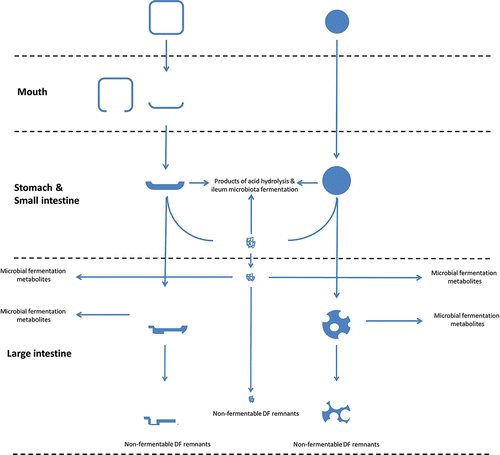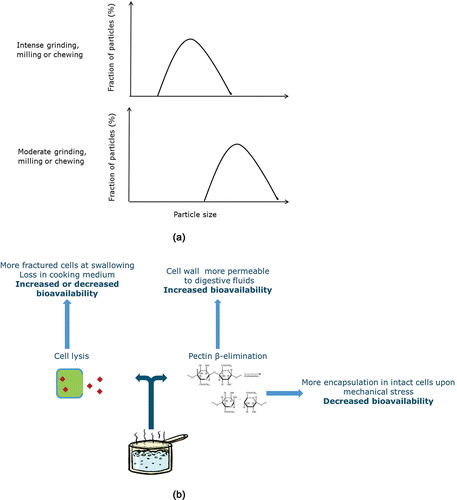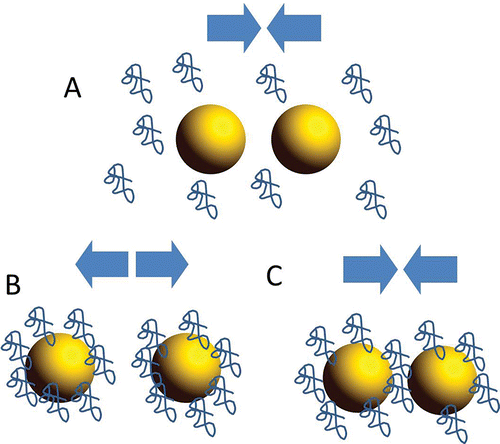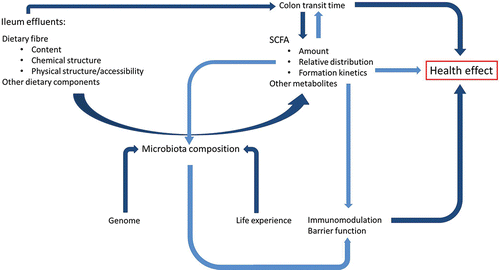Figures & data
Table 1. Chemical composition and source of the most common classes of dietary fiber.
Figure 1. Changes of structural properties of DF during digestion. DF occurs in food in cell walls (a) or particles of varying size (b). Grinding and chewing open up cells and produced fragments of cell wall material. In the stomach and small intestine, DF will absorb water and swell to a degree that depends on its chemical and structural properties which is followed by the solubilization of the soluble DF fraction. Acid hydrolysis in the stomach and ileum microbiota fermentation can occur in the upper intestine. Fermentable DF (both soluble and incorporated in cell walls and particles) is fermented in the large intestine leaving remnants made up of non-fermentable DF.

Table 2. Overview of the effects of DF in each digestion step and their physiological implications.
Figure 2. Effect of industrial, domestic, or oral processing and bio-availability of a generic intracellular nutrient/phytochemical. (a) In raw fruits and vegetables, a more intense mechanical grinding, milling, or chewing increases the fraction of fractured cells that are exposed on the particle surface and thus the nutrient bioavailability. (b) Upon thermal treatment (e.g., domestic cooking), cell wall structure and permeability changes and thus its barrier effect. A fraction of plant cells may lyse releasing their content in the digestive fluids or in the cooking medium, if any. Simultaneously, hydrolysis of pectins in the primary cell wall increases permeability to intracellular compounds whereas hydrolysis of pectin in middle lamella changes the fracture behavior of vegetal tissue, which may result in more cells intact upon chewing or grinding.

Figure 3. Schematic representation of mode of stabilization and destabilization of oil droplets (yellow spheres) in an oil-water emulsion by dietary fiber (blue random coils). (A) When DF does not absorb to the droplet surface, flocculation of lipid droplets may result from the steric effect due to the presence of polymers in the continuous phase (depletion flocculation). (B) when DF stably absorbs on droplet surface forming thick layers, steric repulsion ensues that stabilizes the emulsion. (C) When DF forms incomplete layers on droplet surface, bridging of droplets may cause their flocculation (bridging flocculation).

Figure 4. The complex interplay between diet and microbiota determines the final health effect on the host. Microbiota composition is affected by genetic and individual factors (life experience) and determines how a certain ileum effluent (what enters the large intestine) is converted in SCFA (from DF) and other metabolites (from proteins, lipids, melanoidins, etc.). In turn, bacterial cell wall constituents and products of microbial fermentation contribute to shift the microbiota composition and to modulate the immunological response of the host. Gut microbiota and its metabolic products ultimately contribute to the host health.

